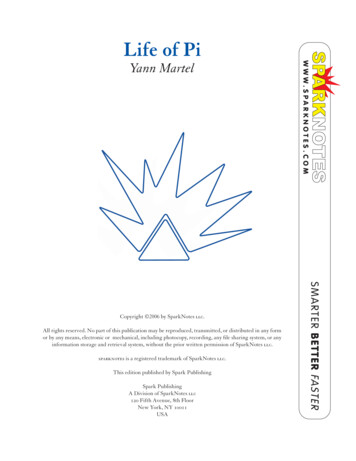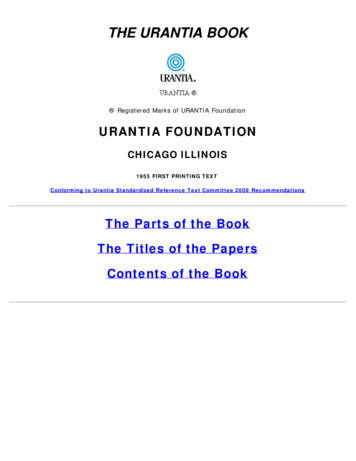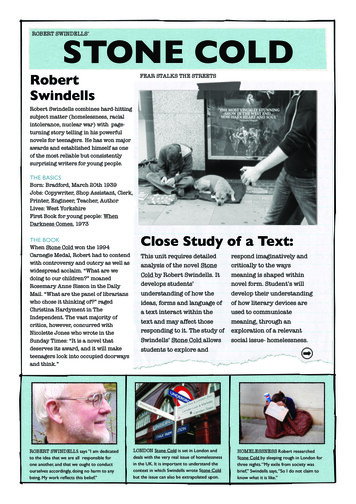
Transcription
Copyright 2006 by SparkNotes llc.All rights reserved. No part of this publication may be reproduced, transmitted, or distributed in any formor by any means, electronic or mechanical, including photocopy, recording, any file sharing system, or anyinformation storage and retrieval system, without the prior written permission of SparkNotes llc.sparknotes is a registered trademark of SparkNotes llc.This edition published by Spark PublishingSpark PublishingA Division of SparkNotes llc120 Fifth Avenue, 8th FloorNew York, NY 10011USASPARKARKNOTESYann MartelW W W. S PA R K N O T E S . C O MLife of Pi
All rights reserved. No part of this publication may be reproduced, transmitted, or distributed in any form or by any means, electronic or mechanical, includingphotocopy, recording, any file sharing system, or any information storage and retrieval system, without the prior written permission of SparkNotes LLC.young boy, his parents joined the Canadian Foreign Services, and the family moved frequently, living inAlaska, France, Costa Rica, Ontario, and British Columbia. Martel went on to study philosophy at Trent University in Ontario, where he discovered a love for writing. After graduating in 1985, Martel lived with hisparents and worked a number of odd jobs while continuing to write fiction. He published a collection of shortstories, The Facts Behind the Helsinki Roccamatios, in 1993 and a novel, Self, in 1996, but neither book receivedmuch critical or commercial attention. In 2002, however, Martel’s international literary reputation was sealedwith the publication of Life of Pi, a runaway bestseller that went on to win the prestigious Man Booker Prize(awarded each year to the best English-language novel written by a Commonwealth or Irish author) and hadsince been translated into thirty languages. Fox 2000 pictures bought the screen rights to Martel’s novel, and afeature film is expected in 2008.Life of Pi is set against the tumultuous period of Indian history known as the Emergency. In 1975, PrimeMinister Indira Gandhi was found guilty of charges related to her 1971 election campaign and was ordered toresign. Instead—and in response to a rising tide of strikes and protests that were paralyzing the government—Gandhi declared a state of emergency, suspending constitutional rights and giving herself the powerto rule by decree. The Emergency lasted for eighteen months and was officially ended in March 1977 whenGandhi called for a new round of elections. The historical legacy of the Emergency has been highly controversial: while civil liberties in this emerging democracy were severely curtailed and Gandhi’s political opponents found themselves jailed, abused, and tortured, India’s economy experienced a much-neededstabilization and growth. In Life of Pi, Piscine (Pi) Molitor Patel’s father, a zookeeper in Pondicherry, India,grows nervous about the current political situation. Speculating that Gandhi might try to take over his zooand faced with depressing economic conditions, Pi’s father decides to sell off his zoo animals and move hisfamily to Canada, thus setting the main action of the novel into motion.Though only a relatively brief section of Life of Pi is actually set in India, the country’s eclectic makeup isreflected throughout the novel. Pi is raised as a Hindu but as a young boy discovers both Christianity andIslam and decides to practice all three religions simultaneously. In the Author’s Note, an elderly Indian mandescribes the story of Pi as “a story that will make you believe in God,” and Life of Pi continuously grappleswith questions of faith; as an adherent to the three most prominent religions in India, Pi provides a uniqueperspective on issues of Indian spirituality. India’s diverse culture is further reflected in Martel’s choice ofPondicherry as a setting. India was a British colony for nearly two hundred years, and consequently most ofthe nation has been deeply influenced by British culture. However, Pondicherry, a tiny city in southern India,was once the capital of French India and as such has retained a uniquely French flavor that sets it apart fromthe rest of the nation. Perhaps reflecting Yann Martel’s own nomadic childhood, Pi Patel pointedly begins hislife in a diverse cultural setting before encountering French, Mexican, Japanese, and Canadian charactersalong his journey.Life of Pi can be characterized as a postcolonial novel, because of its post-Independence Indian setting aswell as its Canadian authorship. Like many postcolonial novels, such as those of Salman Rushdie and GabrielGarcía Márquez, Life of Pi can also be classified as a work of magical realism, a literary genre in which fantastical elements—such as animals with human personalities or an island with cannibalistic trees—appear in anotherwise realistic setting. Martel’s novel could equally be described as a bildungsroman (a coming-of-agetale) or an adventure story. Life of Pi even flirts with nonfiction genres. The Author’s Note, for example,claims that the story of Piscine Molitor Patel is a true story that the author, Yann Martel, heard while backpacking through Pondicherry, and the novel, with its first-person narrator, is structured as a memoir. At theend of the novel, we are presented with interview transcripts, another genre of nonfiction writing. This mixing of fiction and nonfiction reflects the twist ending of the novel, in which the veracity of Pi’s fantastical storyis called into doubt and the reader, like Pi’s Japanese interrogators, is forced to confront unsettling questionsabout the nature of truth itself.Copyright 2006 by SparkNotes LLC.2SPARKARKNOTESYann Martel was born on June 25, 1963, in Salamanca, Spain, to Canadian parents. When Martel was aW W W. S PA R K N O T E S . C O MContext
Copyright 2006 by SparkNotes LLC.SPARKARKNOTEScontext3W W W. S PA R K N O T E S . C O MMany critics have noted the book’s resemblance to Ernest Hemingway’s novel The Old Man and the Sea.Both novels feature an epic struggle between man and beast. In The Old Man and the Sea, a fisherman struggles to pull in a mighty marlin, while in Life of Pi, Pi and Richard Parker struggle for dominance on the lifeboat. Both the fisherman and Pi learn to respect their animal counterparts; each pair is connected in theirmutual suffering, strength, and resolve. Although they are opponents, they are also partners, allies, even doubles. Furthermore, both novels emphasize the importance of endurance. Because death and destruction areinevitable, both novels present life as a choice between only two options: defeat or endurance until destruction. Enduring against all odds elevates both human characters to the status of heroes.Another, less flattering comparison has been drawn between Life of Pi and acclaimed Brazilian authorMoacyr Scliar’s 1981 novel Max and the Cats. In a 2002 interview with Powells.com, Martel discusses readingan unfavorable review of Scliar’s novel in the New York Times Book Review penned by John Updike and,despite Updike’s disparagement, being entranced by the premise. As was later reported, no such reviewexisted, and John Updike himself claimed no knowledge of Scliar’s novel. The similarities between the twonovels are unmistakable: in Max and the Cats, a family of German zookeepers sets sail to Brazil. The ship goesdown and only one young man survives, stranded at sea with a wild jaguar. Martel claims never to have readMax and the Cats before beginning to write Life of Pi. He has since blamed his faulty memory for the Powells.com gaffe and has declined further discussion on the topic. Scliar considered a lawsuit but is said to havechanged his mind after a discussion with Martel. Whatever the real story, Martel mentions Scliar in hisAuthor’s Note, thanking him for “the spark of life.”
Copyright 2006 by SparkNotes LLC.4All rights reserved. No part of this publication may be reproduced, transmitted, or distributed in any form or by any means, electronic or mechanical, includingphotocopy, recording, any file sharing system, or any information storage and retrieval system, without the prior written permission of SparkNotes LLC.SPARKARKNOTESIn an Author’s Note, an anonymous author figure explains that he traveled from his home in Canada to Indiabecause he was feeling restless. There, while sipping coffee in a café in the town of Pondicherry, he met anelderly man named Francis Adirubasamy who offered to tell him a story fantastic enough to give him faith inGod. This story is that of Pi Patel. The author then shifts into the story itself, but not before telling his readerthat the account will come across more naturally if he tells it in Pi’s own voice.Part One is narrated in the first person by Pi. Pi narrates from an advanced age, looking back at his earlierlife as a high school and college student in Toronto, then even further back to his boyhood in Pondicherry. Heexplains that he has suffered intensely and found solace in religion and zoology. He describes how FrancisAdirubasamy, a close business associate of his father’s and a competitive swimming champion, taught him toswim and bestowed upon him his unusual name. Pi is named after the Piscine Molitor, a Parisian swimmingclub with two pools that Adirubasamy used to frequent. We learn that Pi’s father once ran the PondicherryZoo, teaching Pi and his brother, Ravi, about the dangerous nature of animals by feeding a live goat to a tigerbefore their young eyes. Pi, brought up as a Hindu, discovers Christianity, then Islam, choosing to practice allthree religions simultaneously. Motivated by India’s political strife, Pi’s parents decide to move the family toCanada; on June 21, 1977, they set sail in a cargo ship, along with a crew and many cages full of zoo creatures.At the beginning of Part Two, the ship is beginning to sink. Pi clings to a lifeboat and encourages a tiger,Richard Parker, to join him. Then, realizing his mistake in bringing a wild animal aboard, Pi leaps into theocean. The narrative jumps back in time as Pi describes the explosive noise and chaos of the sinking: crewmembers throw him into a lifeboat, where he soon finds himself alone with a zebra, an orangutan, and ahyena, all seemingly in shock. His family is gone. The storm subsides and Pi contemplates his difficult situation. The hyena kills the zebra and the orangutan, and then—to Pi’s intense surprise—Richard Parkerreveals himself: the tiger has been in the bottom of the lifeboat all along. Soon the tiger kills the hyena, and Piand Richard Parker are alone together at sea. Pi subsists on canned water and filtered seawater, emergencyrations, and freshly caught sea life. He also provides for the tiger, whom he masters and trains.The days pass slowly and the lifeboat’s passengers coexist warily. During a bout of temporary blindnessbrought on by dehydration, Pi has a run-in with another blind castaway. The two discuss food and tethertheir boats to one another. When the blind man attacks Pi, intending to eat him, Richard Parker kills him.Not long after, the boat pulls up to a strange island of trees that grow directly out of vegetation, without anysoil. Pi and Richard Parker stay here for a time, sleeping in their boat and exploring the island during the day.Pi discovers a huge colony of meerkats who sleep in the trees and freshwater ponds. One day, Pi finds humanteeth in a tree’s fruit and comes to the conclusion that the island eats people. He and Richard Parker headback out to sea, finally washing ashore on a Mexican beach. Richard Parker runs off, and villagers take Pi to ahospital.In Part Three, two officials from the Japanese Ministry of Transport interview Pi about his time at sea,hoping to shed light on the fate of the doomed ship. Pi tells the story as above, but it does not fully satisfy theskeptical men. So he tells it again, this time replacing the animals with humans: a ravenous cook instead of ahyena, a sailor instead of a zebra, and his mother instead of the orangutan. The officials note that the two stories match and that the second is far likelier. In their final report, they commend Pi for living so long with anadult tiger.W W W. S PA R K N O T E S . C O MPlot Overview
All rights reserved. No part of this publication may be reproduced, transmitted, or distributed in any form or by any means, electronic or mechanical, includingphotocopy, recording, any file sharing system, or any information storage and retrieval system, without the prior written permission of SparkNotes LLC.Richard Parker The Royal Bengal tiger with whom Pi shares his lifeboat. His captor, Richard Parker, namedhim Thirsty, but a shipping clerk made a mistake and reversed their names. From then on, at thePondicherry Zoo, he was known as Richard Parker. Weighing 450 pounds and about nine feet long, hekills the hyena on the lifeboat and the blind cannibal. With Pi, however, Richard Parker acts as anomega, or submissive, animal, respecting Pi’s dominance.The Author The narrator of the (fictitious) Author’s Note, who inserts himself into the narrative at severalpoints throughout the text. Though the author who pens the Author’s Note never identifies himself byname, there are many clues that indicate it is Yann Martel himself, thinly disguised: he lives in Canada,has published two books, and was inspired to write Pi’s life story during a trip to India.Francis Adirubasamy The elderly man who tells the author Pi’s story during a chance meeting in aPondicherry coffee shop. He taught Pi to swim as a child and bestowed upon him his unusual moniker.He arranges for the author to meet Pi in person, so as to get a first-person account of his strange andcompelling tale. Pi calls him Mamaji, an Indian term that means respected uncle.Ravi Pi’s older brother. Ravi prefers sports to schoolwork and is quite popular. He teases his younger brothermercilessly over his devotion to three religions.Santosh Patel Pi’s father. He once owned a Madras hotel, but because of his deep interest in animals decided torun the Pondicherry Zoo. A worrier by nature, he teaches his sons not only to care for and control wildanimals, but to fear them. Though raised a Hindu, he is not religious and is puzzled by Pi’s adoption ofnumerous religions. The difficult conditions in India lead him to move his family to Canada.Gita Patel Pi’s beloved mother and protector. A book lover, she encourages Pi to read widely. Raised Hinduwith a Baptist education, she does not subscribe to any religion and questions Pi’s religious declarations.She speaks her mind, letting her husband know when she disagrees with his parenting techniques.When Pi relates another version of his story to his rescuers, she takes the place of Orange Juice on thelifeboat.Satish Kumar Pi’s atheistic biology teacher at Petit Séminaire, a secondary school in Pondicherry. A poliosurvivor, he is an odd-looking man, with a body shaped like a triangle. His devotion to the power ofscientific inquiry and explanation inspires Pi to study zoology in college.Father Martin The Catholic priest who introduces Pi to Christianity after Pi wanders into his church. Hepreaches a message of love. He, the Muslim Mr. Kumar, and the Hindu pandit disagree about whosereligion Pi should practice.Satish Kumar A plain-featured Muslim mystic with the same name as Pi’s biology teacher. He works in abakery. Like the other Mr. Kumar, this one has a strong effect on Pi’s academic plans: his faith leads Pito study religion at college.Copyright 2006 by SparkNotes LLC.5SPARKARKNOTESPiscine Molitor Patel (Pi) The protagonist of the story. Piscine is the narrator for most of the novel, and hisaccount of his seven months at sea forms the bulk of the story. He gets his unusual name from theFrench word for pool—and, more specifically, from a pool in Paris in which a close family friend,Francis Adirubasamy, loved to swim. A student of zoology and religion, Pi is deeply intrigued by thehabits and characteristics of animals and people.W W W. S PA R K N O T E S . C O MCharacter List
Copyright 2006 by SparkNotes LLC.Nikhil Patel (Nick) Pi’s son. He plays baseball.Usha Patel Pi’s young daughter. She is shy but very close to her father.The Hyena An ugly, intensely violent animal. He controls the lifeboat before Richard Parker emerges.The Zebra A beautiful male Grant’s zebra. He breaks his leg jumping into the lifeboat. The hyena tormentshim and eats him alive.Orange Juice The maternal orangutan that floats to the lifeboat on a raft of bananas. She suffers almosthumanlike bouts of loneliness and seasickness. When the hyena attacks her, she fights back valiantlybut is nonetheless killed and decapitated.The Blind Frenchman A fellow castaway whom Pi meets by chance in the middle of the ocean. Driven byhunger and desperation, he tries to kill and cannibalize Pi, but Richard Parker kills him first.Tomohiro Okamoto An official from the Maritime Department of the Japanese Ministry of Transport, who isinvestigating the sinking of the Japanese Tsimtsum. Along with his assistant, Atsuro Chiba, Okamotointerviews Pi for three hours and is highly skeptical of his first account.Atsuro Chiba Okamoto’s assistant. Chiba is the more naïve and trusting of the two Japanese officials, and hisinexperience at conducting interviews gets on his superior’s nerves. Chiba agrees with Pi that theversion of his ordeal with animals is the better than the one with people.The Cook The human counterpart to the hyena in Pi’s second story. He is rude and violent and hoards food onthe lifeboat. After he kills the sailor and Pi’s mother, Pi stabs him and he dies.The Sailor The human counterpart to the zebra in Pi’s second story. He is young, beautiful, and exotic. Hespeaks only Chinese and is very sad and lonely in the lifeboat. He broke his leg jumping off the ship,and it becomes infected. The cook cuts off the leg, and the sailor dies slowly.character list6SPARKARKNOTESMeena Patel Pi’s wife, whom the author meets briefly in Toronto.W W W. S PA R K N O T E S . C O MThe Hindu Pandit One of three important religious figures in the novel. Never given a name, he is outragedwhen Pi, who was raised Hindu, begins practicing other religions. He and the other two religiousleaders are quieted somewhat by Pi’s declaration that he just wants to love God.
All rights reserved. No part of this publication may be reproduced, transmitted, or distributed in any form or by any means, electronic or mechanical, includingphotocopy, recording, any file sharing system, or any information storage and retrieval system, without the prior written permission of SparkNotes LLC.Piscine Molitor Patel is the protagonist and, for most of the novel, the narrator. In the chapters that frame themain story, Pi, as a shy, graying, middle-aged man, tells the author about his early childhood and the shipwreck that changed his life. This narrative device distances the reader from the truth. We don’t knowwhether Pi’s story is accurate or what pieces to believe. This effect is intentional; throughout Pi emphasizesthe importance of choosing the better story, believing that imagination trumps cold, hard facts. As a child, hereads widely and embraces many religions and their rich narratives that provide meaning and dimension tolife. In his interviews with the Japanese investigators after his rescue, he offers first the more fanciful versionof his time at sea. But, at their behest, he then provides an alternative version that is more realistic but ultimately less appealing to both himself and his questioners. The structure of the novel both illustrates Pi’s defining characteristic, his dependence on and love of stories, and highlights the inherent difficulties in trusting hisversion of events.Though the narrative jumps back and forth in time, the novel traces Pi’s development and maturation in atraditional bildungsroman, or coming-of-age story. Pi is an eager, outgoing, and excitable child, dependenton his family for protection and guidance. In school, his primary concerns involve preventing his schoolmatesfrom mispronouncing his name and learning as much as he can about religion and zoology. But when the shipsinks, Pi is torn from his family and left alone on a lifeboat with wild animals. The disaster serves as the catalyst in his emotional growth; he must now become self-sufficient. Though he mourns the loss of his familyand fears for his life, he rises to the challenge. He finds a survival guide and emergency provisions. Questioning his own values, he decides that his vegetarianism is a luxury under the conditions and learns to fish. Hecapably protects himself from Richard Parker and even assumes a parental relationship with the tiger, providing him with food and keeping him in line. The devastating shipwreck turns Pi into an adult, able to fendfor himself out in the world alone.Pi’s belief in God inspires him as a child and helps sustain him while at sea. In Pondicherry, his atheisticbiology teacher challenges his Hindu faith in God, making him realize the positive power of belief, the needto overcome the otherwise bleakness of the universe. Motivated to learn more, Pi starts practicing Christianity and Islam, realizing these religions all share the same foundation: belief in a loving higher power. His burgeoning need for spiritual connection deepens while at sea. In his first days on the lifeboat, he almost gives up,unable to bear the loss of his family and unwilling to face the difficulties that still await him. At that point,however, he realizes that the fact he is still alive means that God is with him; he has been given a miracle. Thisthought gives him strength, and he decides to fight to remain alive. Throughout his adventure, he prays regularly, which provides him with solace, a sense of connection to something greater, and a way to pass the time.Richard ParkerPi’s companion throughout his ordeal at sea is Richard Parker, a 450-pound Royal Bengal tiger. Unlike manynovels in which animals speak or act like humans, Richard Parker is portrayed as a real animal that acts inways true to his species. It can be difficult to accept that a tiger and a boy could exist on a lifeboat alone, however, in the context of the novel, it seems plausible. Captured as a cub, Parker grew up in the zoo and is accustomed to a life in captivity. He is used to zookeepers training and providing for him, so he is able to respond tocues from Pi and submit to his dominance. However, he is no docile house cat. He has been tamed, but he stillacts instinctually, swimming for the lifeboat in search of shelter and killing the hyena and the blind castawayfor food. When the two wash up on the shore of Mexico, Richard Parker doesn’t draw out his parting with Pi,he simply runs off into the jungle, never to be seen again.Though Richard Parker is quite fearsome, ironically his presence helps Pi stay alive. Alone on the lifeboat,Pi has many issues to face in addition to the tiger onboard: lack of food and water, predatory marine life,treacherous sea currents, and exposure to the elements. Overwhelmed by the circumstances and terrified ofCopyright 2006 by SparkNotes LLC.7SPARKARKNOTESPiscine Molitor PatelW W W. S PA R K N O T E S . C O MAnalysis of Major Characters
Copyright 2006 by SparkNotes LLC.SPARKARKNOTESanalysis of major characters8W W W. S PA R K N O T E S . C O Mdying, Pi becomes distraught and unable to take action. However, he soon realizes that his most immediatethreat is Richard Parker. His other problems now temporarily forgotten, Pi manages, through several training exercises, to dominate Parker. This success gives him confidence, making his other obstacles seem lessinsurmountable. Renewed, Pi is able to take concrete steps toward ensuring his continued existence: searching for food and keeping himself motivated. Caring and providing for Richard Parker keeps Pi busy andpasses the time. Without Richard Parker to challenge and distract him, Pi might have given up on life. Afterhe washes up on land in Mexico, he thanks the tiger for keeping him alive.Richard Parker symbolizes Pi’s most animalistic instincts. Out on the lifeboat, Pi must perform manyactions to stay alive that he would have found unimaginable in his normal life. An avowed vegetarian, hemust kill fish and eat their flesh. As time progresses, he becomes more brutish about it, tearing apart birds andgreedily stuffing them in his mouth, the way Richard Parker does. After Richard Parker mauls the blindFrenchman, Pi uses the man’s flesh for bait and even eats some of it, becoming cannibalistic in his unrelentinghunger. In his second story to the Japanese investigators, Pi is Richard Parker. He kills his mother’s murderer.Parker is the version of himself that Pi has invented to make his story more palatable, both to himself and tohis audience. The brutality of his mother’s death and his own shocking act of revenge are too much for Pi todeal with, and he finds it easier to imagine a tiger as the killer, rather than himself in that role.
All rights reserved. No part of this publication may be reproduced, transmitted, or distributed in any form or by any means, electronic or mechanical, includingphotocopy, recording, any file sharing system, or any information storage and retrieval system, without the prior written permission of SparkNotes LLC.The Will to LiveLife of Pi is a story about struggling to survive through seemingly insurmountable odds. The shipwreckedinhabitants of the little lifeboat don’t simply acquiesce to their fate: they actively fight against it. Pi abandonshis lifelong vegetarianism and eats fish to sustain himself. Orange Juice, the peaceful orangutan, fights ferociously against the hyena. Even the severely wounded zebra battles to stay alive; his slow, painful struggle vividly illustrates the sheer strength of his life force. As Martel makes clear in his novel, living creatures willoften do extraordinary, unexpected, and sometimes heroic things to survive. However, they will also doshameful and barbaric things if pressed. The hyena’s treachery and the blind Frenchman’s turn toward cannibalism show just how far creatures will go when faced with the possibility of extinction. At the end of thenovel, when Pi raises the possibility that the fierce tiger, Richard Parker, is actually an aspect of his own personality, and that Pi himself is responsible for some of the horrific events he has narrated, the reader is forcedto decide just what kinds of actions are acceptable in a life-or-death situation.The Importance of StorytellingLife of Pi is a story within a story within a story. The novel is framed by a (fictional) note from the author,Yann Martel, who describes how he first came to hear the fantastic tale of Piscine Molitor Patel. Within theframework of Martel’s narration is Pi’s fantastical first-person account of life on the open sea, which forms thebulk of the book. At the end of the novel, a transcript taken from an interrogation of Pi reveals the possible“true” story within that story: that there were no animals at all, and that Pi had spent those 227 days with otherhuman survivors who all eventually perished, leaving only himself.Pi, however, is not a liar: to him, the various versions of his story each contain a different kind of truth. Oneversion may be factually true, but the other has an emotional or thematic truth that the other cannotapproach. Throughout the novel, Pi expresses disdain for rationalists who only put their faith in “dry, yeastless factuality,” when stories—which can amaze and inspire listeners, and are bound to linger longer in theimagination—are, to him, infinitely superior.Storytelling is also a means of survival. The “true” events of Pi’s sea voyage are too horrible to contemplatedirectly: any young boy would go insane if faced with the kinds of acts Pi (indirectly) tells his integrators hehas witnessed. By recasting his account as an incredible tale about humanlike animals, Pi doesn’t have to facethe true cruelty human beings are actually capable of. Similarly, by creating the character of Richard Parker,Pi can disavow the ferocious, violent side of his personality that allowed him to survive on the ocean. Even thisis not, technically, a lie in Pi’s eyes. He believes that the tiger-like aspect of his nature and the civilized, humanaspect stand in tense opposition and occasional partnership with one another, just as the boy Pi and the tigerRichard Parker are both enemies and allies.The Nature of Religious BeliefLife of Pi begins with an old man in Pondicherry who tells the narrator, “I have a story that will make youbelieve in God.” Storytelling and religious belief are two closely linked ideas in the novel. On a literal level,each of Pi’s three religions, Hinduism, Christianity, and Islam, come with its own set of tales and fables,which are used to spread the teachings and illustrate the beliefs of the faith. Pi enjoys the wealth of stories, buthe also senses that, as Father Martin assured him was true of Christianity, each of these stories might simplybe aspects of a greater, universal story about love.Copyright 2006 by SparkNotes LLC.9SPARKARKNOTESThemesW W W. S PA R K N O T E S . C O MThemes, Motifs & Symbols
Copyright 2006 by SparkNotes LLC.Territorial DominanceThough Martel’s text deals with the seemingly boundless nature of the sea, it also studies the strictness ofboundaries, borders, and demarcations. The careful way in which Pi marks off his territory and differentiatesit from Richard Parker’s is necessary for Pi’s survival. Animals are territorial creatures, as Pi notes: a familydog, for example, will guard its bed from intruders as if it were a lair. Tigers, as we learn from RichardParker, are similarly territorial. They mark their space and define its boundaries carefully, establishing absolute dominance over every square inch of their area. To master Richard Parker, Pi must establish his controlover certain zones in the lifeboat. He pou
Life of Pi, a runaway bestseller that went on to win the prestigious Man Booker Prize (awarded each year to the best English-language novel written by a Commonwealth or Irish author) and had since been translated into thirty languages. Fox 2000 pictures bought the screen rights to Martel's novel, and a feature film is expected in 2008. Life .










